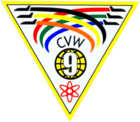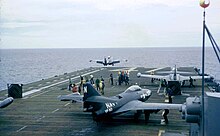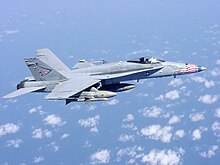Carrier Air Wing Nine
|
Carrier Air Wing Nine |
|
|---|---|

|
|
| Lineup | March 26, 1952 |
| Country |
|
| Armed forces | United States Navy |
| Strength | approx. 2,500 |
| Location | Naval Air Station Lemoore, CA USS John C. Stennis (CVN 74) |
| Nickname | Shogun |
| motto | "Excellence in Motion" |
The Carrier Air Wing Nine (CVW-9) is a carrier squadron for the U.S. Navy . It was set up in March 1942 as Carrier Air Group 9 (CVG-9) and decommissioned in October 1945. In March 1952 CVG-9 was reactivated and in December 1963 renamed "Carrier Air Wing 9 (CVW-9)".
history
1942-1945
Carrier Air Group 9 (CVG-9) entered service on March 1, 1942 for the Essex aircraft carrier under construction . The squadron consisted of the VF-9 Fighter Squadron, equipped with Grumman F4F-4 Wildcat , the VB-9 bomber squadron and the VS-9 reconnaissance squadron. Both squadrons were equipped with the Vought SB2U-2 Vindicator . The torpedo squadron VT-9 had to wait for the delivery of the Grumman TBF-1 Avenger .
Due to the small number of crews and aircraft available in 1942, CVG-9 was embarked on the aircraft carrier Ranger in August 1942 to take part in the invasion of North Africa . However, from all squadrons of the squadron only VF-9 was on board, the other squadrons VF-41 and VS-41 came from the CVG-4. On November 8, 1942, the squadron's planes attacked the French airfields at Rabat and Port Lyautey and ships in the port of Casablanca . In total, the CVG-9 aircraft flew 496 missions in three days. The bombers damaged the battleship Jean Bart , the cruiser Primauguet and the destroyer Albatros . In addition, 70 aircraft were destroyed on the ground and 15 in the air. The squadron lost 16 aircraft. On November 23, the Ranger finally returned to the USA.
Before being used on the Essex , the squadron's squadrons were equipped with more modern types of aircraft in early 1943. VF-9 received the Grumman F6F-3 Hellcat , VS-9 was integrated into the VB-9 and equipped with the Douglas SBD Dauntless . In May 1943 the carrier moved to the Pacific. On August 15, 1943, aircraft of the Marcus Island squadron attacked , on October 5 and 6, the island of Wake and on November 11, the Japanese naval base Rabaul in New Britain . From November 18 to 23, CVG-9 supported the landings on Gilbert Island Tarawa . On December 4th, Kwajalein was attacked. The landings on the atoll then took place with the support of CVG-9 from January 29 to February 3, 1944. On February 17 and 18, 1944, the squadron was involved in the attack on the Japanese base Truk on the Karolinen . Then the Essex went to the USA for an overhaul. On the way back, aircraft of the squadron attacked targets in the Mariana Islands on February 23 .
Until the beginning of 1945 the squadron was refreshed in the USA. Here the squadron VB-9 received new Curtiss SB2C Helldiver . In February 1945 the squadron was embarked on the aircraft carrier Lexington . Targets in the Tokyo area were attacked on February 16 and 17 and the landing on Iwojima was supported from February 19 to 21 . Attacks on Japan followed again . Since the Lexington had to be overhauled in the USA, CVG-9 moved to Yorktown in March 1945 . In preparation for the landings on Okinawa , the squadron's planes attacked targets on Okinawa itself and on Kyushu from March 18 . From April 1st, the landings themselves were supported. On April 7, the planes were involved in the sinking of the Japanese battleship Yamato , the light cruiser Yahagi and four destroyers.
In June 1945 the squadron switched back to the Lexington , which had returned from the USA . Targets in Japan were attacked in July and the first half of August. After the war ended, Carrier Air Group 9 was decommissioned on October 15, 1945.
1946-1948
On November 15, 1946, the CVAG-20 squadron, which was commissioned in 1943, was renamed CVAG-9. From February to June 1948, the squadron made a mission on the aircraft carrier Philippine Sea into the Mediterranean. On December 1, 1949, the squadron was decommissioned without having carried out any further deployment trips.
Since 1952
On March 26, 1952, the squadron was reorganized. From December 1952 he was first used in the Korean War on board the aircraft carrier Philippine Sea . The next mission on the Hornet was a special one, as the carrier circled the earth eastward from May 11th to December 12th, 1954. In 1956 and 1957/58 mission trips followed to the Western Pacific on the Oriskany and Ticonderoga carriers . Between 1960 and 1965, the new Ranger was deployed four times , the last of which took place during the Vietnam War . In December 1963 "Carrier Air Group 9" was renamed "Carrier Air Wing 9 (CVW-9)".
Between October 1965 and July 1969, four more trips to Vietnam followed, this time on the Enterprise carrier . On January 14, 1969, there was a serious incident during a maneuver off Oahu . Heated up by the hot exhaust gases from a plane taking off, the warhead of a Zuni missile exploded at 8:19 a.m. and tore a hole in the tank of the fully fueled plane. The fire caused by the leaking fuel spread across the entire aft flight deck, where several aircraft were fully fueled and armed for the planned maneuver. Over the next 15 minutes, there were several major bomb explosions that detonated in the heat of the fire. 25 people died on board the Enterprise . 371 crew members were injured, 62 of them had to be taken to hospital in Oahu because their burns could not be treated adequately on board. 15 aircraft were destroyed, 17 damaged.
After the following mission, the Enterprise had to go to the shipyard and CVW-9 moved to America for a period of service in 1970. From 1971 to 1982 the squadron remained stationed on the aircraft carrier Constellation for seven missions . During the 1972 mission, the pilots Randall H. Cunningham and William P. Driscoll of the VF-96 Black Falcons fighter squadron became the most successful fighter pilots in the US Navy during the Vietnam War. The squadron's aircraft were also instrumental in the mining of North Vietnamese ports during Operation Linebaker I. After the end of the war there were regular trips to the western Pacific. In March 1979, the Constellation was operating in the Gulf of Aden because of tensions between North and South Yemen. In 1980, the porter stayed in the Indian Ocean for 110 days during the hostage situation in Tehran .
When the Constellation was due for a shipyard overhaul in 1982, CVW-9 switched again to the Ranger in 1983/84 . In 1985 and 1987 two more trips followed on the Kitty Hawk , the latter again leading around the globe. From 1988 to 1998 the squadron was stationed on the Nimitz . CVW-9 made six mission trips to the Pacific and Indian Oceans, the last of which again circled the earth. In July and August 1998 a short drive use on the carriers Kitty Hawk and Independence , when the Kitty Hawk , the Independence than in Japan stationed carrier replaced.
In 2000 the squadron changed to the John C. Stennis . During the second mission on the John C. Stennis in 2001/2002, the squadron was deployed in Operation Enduring Freedom in Afghanistan . 2003 to 2005 the squadron changed to the Carl Vinson . During the second period of use in 2005, CVW-9 was used in the Iraq war .
When Colonel Doug Yuroveich became Commander Air Group (Geschwaderkommodore) of CVW-9 in 2006 , an officer in the United States Marine Corps "CAG" became a carrier squadron for the first time . Since 2007 the squadron has been stationed on the John C. Stennis again . The squadron completed 2007, 2009, 2011–2012 and 2012–2013 further missions aboard the John C. Stennis in the Pacific and Indian Oceans. After all combat squadrons had been converted to the Boeing F / A-18E / F and EA-18G Super Hornet , the John C. Stennis left for the current mission on January 15, 2016.
Composition today
The US Navy has had a fixed system for identifying squadrons or squadrons ( Visual Identification System for Naval Aircraft ) since 1945 . Initially, this consisted of geometric patterns on the tail unit. However, since these were difficult to remember or to describe, letters were introduced as early as June 1945 to distinguish the squadrons. CVG-9 was assigned the identifier "PS" (derived from the carrier name "Philippine Sea") in November 1946. From September 1948 to the end of 1949 the identification letter "D" was valid, which was then changed to "N" after the re-installation in March 1952.
In 1957 the individual letters were replaced by doubles. In general, the squadrons of the Atlantic Fleet have an "A" as the first letter and those of the Pacific Fleet an "N". The Carrier Air Wing NINE can be recognized by the code ( tail code ) NG . The individual squadrons of the squadron are numbered in increments of 100, the aircraft of the squadron commander ( Commander, Air Group - CAG) can be recognized by the tactical number ending in "00".
The Carrier Air Wing Nine (CVW-9) currently (October 2010) includes the following squadrons:
| tactical number | Season | Aircraft type | Nickname | Radio callsign |
|---|---|---|---|---|
| from 100 | VFA-41 | Boeing F / A-18F | Black Aces | Almost eagle |
| From 200 | VFA-14 | Boeing F / A-18E | Tophatters | Cam / Camelot |
| from 300 | VFA-97 | Boeing F / A-18E | Warhawks | Hawk / War Ace |
| from 400 | VFA-151 | Boeing F / A-18E | Vigilantes | |
| from 500 | VAQ-133 | Boeing EA-18G Growler | Wizards | |
| from 600 | VAW-112 | Grumman E-2C Hawkeye | Golden Hawks | Ghost |
| from 610 | HSC-14 | Sikorsky MH-60S Seahawk | Chargers | |
| from 700 | HSM-71 | Sikorsky MH-60R Seahawk | Raptors | |
| xx | VRC-30 Det. 4 | Grumman C-2A Greyhound | Providers | Password |
Web links
- Official website of the CVW-9 (English)
- CVW-8 on GlobalSecurity.org (English)
- Site from Japan with comprehensive information on squadrons and squadrons (English)
- United States Naval Aviation 1910-1995. (No longer available online.) In: history.navy.mil. US Naval Institute, archived from the original on October 15, 2014 (English, table of contents; PDF documents for download).
Individual evidence
- ↑ USS Ranger (CV 4) ( Memento from April 13, 2009 in the Internet Archive )
- ↑ USS Exxex (CV 9) ( Memento from December 25, 2008 in the Internet Archive )
- ↑ http://www.history.navy.mil/nan/backissues/1940s/1948/feb48.pdf
- ↑ USS Lexington (CV-16) ( Memento February 1, 2006 in the Internet Archive )
- ↑ USS Enterprise (CVN-65) ( Memento April 27, 2006 in the Internet Archive )
- ↑ USS Constellation (CVA 64) ( Memento from December 28, 2008 in the Internet Archive )
- ↑ USS John C. Stennis Deploys , US Navy press release NNS160117-01 January 17, 2016.
- ↑ USN Aircraft Carrier Air Units Vol. 1, Squadron Signal Publications, 1985
- ↑ http://www.history.navy.mil/content/dam/nhhc/research/histories/naval-aviation/pdf/app23.pdf
- ↑ http://www.gonavy.jp/CVW-NGf.html



